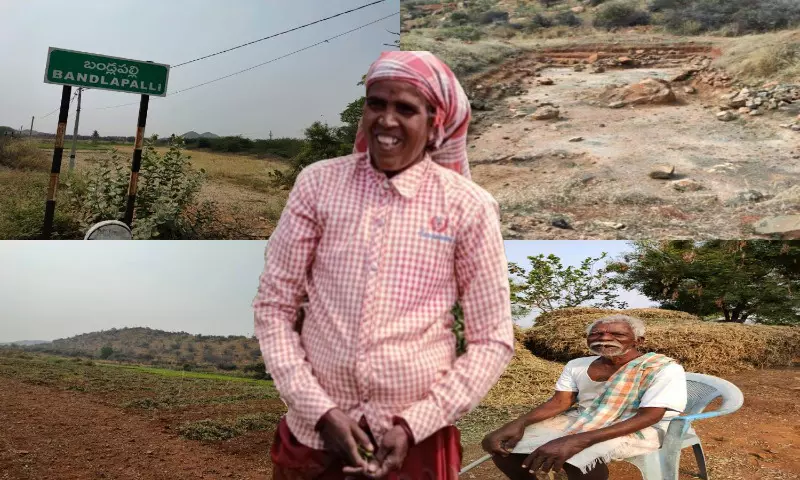From poverty to prosperity: MGNREGS brings windfall to Bandlapalli villagers in 15 years
By Jinka Nagaraju
It's very rare that an entire village owes its total transformation, from poverty to prosperity, to a single scheme launched way back in 2006.
Normally government welfare schemes do not present uniform results. But, the Mahatma Gandhi National Rural Employment Guarantee Scheme (MGNREGS) is altogether a different kettle of fish. The scheme brought a permanent and uniform change in Bandlapalli, the first village chosen to launch the scheme on February 2, 2006, by former Prime Minister Manmohan Singh.
Villagers said the era of economic distress caused by the drought is over. The village is once again the news as the scheme has completed 15 years.
The entire village, comprising mostly of upper-caste Reddys and BCs, is the beneficiary of the scheme. The social wellbeing of the village is evident in every lane of the village. The drought-prone village was set in a beautiful natural environment surrounded by hills that played a crucial role in the transformation of the village.
Before 2006, the rainwater that flowed down the hills surreptitiously crawled into a far-off Pappuru tank without being noticed by the villagers. What the NERGS did was unravel the potential of rainwater harvesting through NREGS works (Karuvu panulu), which provided the villagers guaranteed employment for 100 days during the drought season.
Little did the villagers know that the scheme, meant to provide guaranteed employment to stop the migrations, was paving the path for a silent revolution.
NERGS works, taken up in the form of farm-ponds, check dams and percolation tanks, etc worked wonders in harvesting rainwater. It replenished the groundwater table. Villagers say water is available just 150 ft below the surface. Once drought-ravaged, Bandlaplalli is now a vibrant place with multi-crop lands. Villagers cultivate from flowers to fruits to sugarcane. "The scheme has proven our lands are gold," said former Sarpanch Velpula Narayana Reddy.
Not a single soul talks ill of the program and everybody fondly recalls the trajectory the village passed in the past 15 years to reach the present stage.
The village, where once the word graduate was unheard of now boasts of having as many as 30 B.Tech students and a few software engineers. Education with English medium has become first priority of every family.
"Every family is sending their children to the school. The starting of English medium in the local government school is a boon for our children. No family now wants their children to work on the farm. This attitudinal change is the result of the availability of water in the village. We have now enough water for cultivation as well as drinking. Going for a km or so for a pot of water is long gone. Launching of water conservation works has raised the groundwater table to such an extent that entire land of the village has come under cultivation," narrated village Sarpanch Pittu Venkata Narayanamma, who is also a job-card holder.
Talk to Akuleti Gangamma, who was one of the two women laborers to receive the MGNREGS first job-card from Prime Minister Manmohan Singh in 2006, you would know the impact the scheme heralded in the lives of the laborers.
Gangamma was finding it difficult to hide the fact that she bought 2 tolas of gold, a dream for every woman and normally unthinkable for a woman laborer, from the money she could save from her regular employment. Buying gold is her triumph over poverty.
"There is enough work for all laborers in the village itself and every woman earns now Rs 200 to Rs 350 a day. When farm works are not available NERGS is there to fall back upon. Some women work in two shifts, morning and evening. The guaranteed employment has halted all sorts of migrations," said Jaipal, MGNREGS field assistant.
According to villagers, all those who migrated to cities in search of work earlier have returned home.
Recalling the bad days of the village, when it was the stage for gruesome murders and chronic droughts, former Sarpanch Narayana Reddy said the entire village was reaping the benefits of a good scheme. He was the village Sarpanch when the scheme was launched on February 2, 2006.
"Whatever improvement that is visible in the village or in the lives of the people is the result of the MGNREGS. It resolved the terrible water crisis of the village. Water changed the agricultural profile. All have enough work to do. Farmers are sinking bore wells which was not the case before the launch of the scheme. We are happy now.
But, to be happier we want a permanent water source in the form of a branch canal from Handri Neeva Sujala Sravanti canal," said Narayana Reddy, recalling how he was forced to sit between PM Manmohan Singh and Sonia Gandhi by the then chief minister YSR. "I was sitting at the far end of the row on the stage. YSR came to me and lifted me from the chair. He made me walk to a chair by the side of Prime Minister Manmohan Singh," Reddy said with child-like excitement.
He was unequivocal in stating that the village owes every development in the village to the scheme.
For the latecomers, the MGNERGS was launched in 200 villages across the country in phase-1 by the UPA I government in 2006. Bandlapalli is a village 56 KM from the district headquarters of Anantapuramu. Euphemistically, the district is referred to as Jaisalmer of Andhra Pradesh because of its scant rainfall. So, the district has been the beneficiary of some pilot projects meant for drought-prone areas.
The village was chosen as the ideal village for the launch of the MGNREGS because of many socio-cultural and economic reasons, the important being its disturbing bloody history of village-faction in which dozen were mercilessly killed, history of chronic droughts, and pathetic history of migrations to places such as Bengaluru, Guntur, and Hyderabad in search of work.